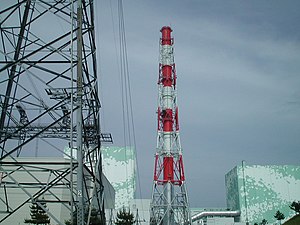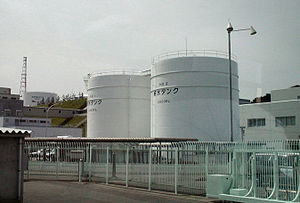Showing posts with label Tokyo Electric Power Company. Show all posts
Showing posts with label Tokyo Electric Power Company. Show all posts
Thursday, August 29, 2013
As Fukushima Raises Severity Level, Nuclear Expert Warns Radioactive Leaks Will Only "Get Worse"
Japan’s nuclear regulator said today it has officially raised the severity rating of the latest radioactive water leak at the crippled Fukushima nuclear plant to Level 3 on an international scale for radiological releases.
The plant’s operator, Tokyo Electric Power Co (TEPCO), said last week that 330 tons of highly radioactive water leaked from a storage tank at the facility. Crews of workers have been rushing to check for leaks in hundreds of other tanks holding radioactive water. Japanese regulators have accused TEPCO of failing to properly monitor the storage tanks.
"The problem is going to get worse," warns Arnie Gundersen, a former nuclear industry executive who has coordinated projects at 70 nuclear power plants around the United States. "Radioactive water is leaking out of this plant as fast as it is leaking in." Read more >>
Monday, August 19, 2013
Tritium Measurement In Fukushima Bay Highest Ever As TEPCO Admits 40 Trillion Becquerels Have Spilled Into Pacific
Over the weekend we posted an in-depth narrative of what may happen in a theoretical worst case scenario in Fukushima, one in which the government continues to do nothing and pretends all is well, and where the end casualties are millions of innocent Japanese (and other) citizens, whose only crime is believing their government.
Sadly, with every passing day the theoretical is becoming all too real, and moments ago reality struck again, when the Nikkei newspaper reported that readings of tritium in seawater taken from the bay near the crippled Fukushima nuclear plant has shown 4700 becquerels per liter. Read more >>
Sadly, with every passing day the theoretical is becoming all too real, and moments ago reality struck again, when the Nikkei newspaper reported that readings of tritium in seawater taken from the bay near the crippled Fukushima nuclear plant has shown 4700 becquerels per liter. Read more >>
Monday, August 5, 2013
Japan nuclear body says radioactive water at Fukushima an 'emergency'
This contaminated groundwater has breached an underground barrier, is rising toward the surface and is exceeding legal limits of radioactive discharge, Shinji Kinjo, head of a Nuclear Regulatory Authority (NRA) task force, told Reuters.
Countermeasures planned by Tokyo Electric Power Co are only a temporary solution, he said.
Tepco's "sense of crisis is weak," Kinjo said. "This is why you can't just leave it up to Tepco alone" to grapple with the ongoing disaster.
"Right now, we have an emergency," he said.
Tepco has been widely castigated for its failure to prepare for the massive 2011 tsunami and earthquake that devastated its Fukushima plant and lambasted for its inept response to the reactor meltdowns. It has also been accused of covering up shortcomings. Read more >>
Monday, July 22, 2013
Fukushima Plant Admits Radioactive Water Leaking To Sea
 |
| Fukushima I nuclear power plant before the 2011 explosion. (Photo credit: Wikipedia) |
Tokyo Electric Power Co., which operates the Fukushima Dai-ichi plant, also came under fire Monday for not disclosing earlier that the number of plant workers with thyroid radiation exposures exceeding threshold levels for increased cancer risks was 10 times what it said released earlier.
The delayed announcements underscored the criticisms the company has faced over the Fukushima crisis. TEPCO has been repeatedly blamed for overlooking early signs, and covering up or delaying the disclosure of problems and mishaps.
Company spokesman Masayuki Ono told a regular news conference that plant officials have come to believe that radioactive water that leaked from the wrecked reactors is likely to have seeped into the underground water system and escaped into sea. Read more >>
Tuesday, July 16, 2013
Contaminated Water Leaking into Ocean for Two Years at Fukushima
The problem stems from the fact that ground water is leaking into the basement of the damaged reactors, and becoming contaminated, and whilst that water is being pumped out and stored in huge tanks on site, the inflow has not yet been stopped, meaning that ever more ground water enters the basement and becomes contaminated.
Tanaka explains that neither his staff, nor those working for the plant’s operator have discovered where the leaks are coming from, and therefore have not been able to stop them.
Tokyo Electric Power (Tepco), the power plants operator, has constantly denied that any of that water heas been leaking into the Ocean, but in the last few days it has switched its position and finally admitted that it can’t actually say for sure that the water is not leaking into the sea. Read more >>
Wednesday, July 10, 2013
Former Fukushima nuclear plant boss dies of cancer
Masao Yoshida, 58, was at the Japanese power station on March 11, 2011, when towering waves swamped cooling systems and sparked meltdowns that released plumes of radiation.
Yoshida led the subsequent effort to get the crippled complex under control, as workers battled frequent aftershocks to try to prevent the disaster worsening.
Government contingency plans revealed after the event showed how scientists feared a chain reaction if Fukushima spiralled out of control, a scenario that could have seen other nuclear plants engulfed and would have meant evacuating Tokyo. Read more >>
Wednesday, March 30, 2011
Toxic plutonium seeping from Japan's nuclear plant
 Image via WikipediaHighly toxic plutonium is seeping from the damaged nuclear power plant in Japan's tsunami disaster zone into the soil outside, officials said Tuesday, as the government grew frustrated by missteps in the effort to stabilize the overheated facility.
Image via WikipediaHighly toxic plutonium is seeping from the damaged nuclear power plant in Japan's tsunami disaster zone into the soil outside, officials said Tuesday, as the government grew frustrated by missteps in the effort to stabilize the overheated facility.Safety officials said the small amounts of plutonium found at several spots outside the complex were not a risk to humans but support suspicions that dangerously radioactive water is leaking from damaged nuclear fuel rods -- a worrying development in the race to bring the power plant under control.
"The situation is very grave," Chief Cabinet Secretary Yukio Edano told reporters Tuesday. "We are doing our utmost efforts to contain the damage."
A tsunami spawned by a magnitude-9.0 earthquake March 11 destroyed the power systems needed to cool the nuclear fuel rods at the Fukushima Dai-ichi complex, 140 miles (220 kilometers) northeast of Tokyo.
Since then, three of the plant's six reactors are believed to have partially melted down, and emergency crews have grappled with everything from malfunctioning pumps to dangerous spikes in radiation that have sent workers fleeing.
Radiation seeping from the plant has made its way into produce, raw milk and even tap water as far away as Tokyo, prompting some nations to halt imports from the region. Residents within a 12-mile (20-kilometer) radius of the plant have been urged to leave or stay indoors. More...
Monday, March 14, 2011
Washington Post article that cuts thru all of Japan's Nuclear LIES
 Image via WikipediaJapanese plant races to contain meltdowns after two blasts; third reactor loses cooling capacity
Image via WikipediaJapanese plant races to contain meltdowns after two blasts; third reactor loses cooling capacityChico Harlan and Steven Mufson, Monday, March 14
TOKYO — A second explosion rocked Japan’s seaside Fukushima Daiichi nuclear complex Monday, this time destroying an outer building at unit 3. A Japanese government official separately said that a third reactor at the six-reactor facility had lost its cooling capacity, adding to the complications facing the engineers who try to limit the damage of a partial meltdown.
Like the Saturday explosion at unit 1, the blast at unit 3 took place after a buildup of hydrogen was vented by the reactor. The hydrogen was produced by the exposure of the reactor’s fuel rods and their zirconium alloy casing to hot steam.
In normal conditions, the fuel rods would be covered and cooled by water.
The explosion occurred as Tokyo Electric entered day four of its battle against a cascade of failures at its two Fukushima nuclear complexes, using fire pumps to inject tens of thousands of gallons of seawater into two reactors to contain partial meltdowns of ultra-hot fuel rods.
The tactic produced high pressures and vapors that the company vented into its containment structures and then into the air, raising concerns about radioactivity levels in the surrounding area where people have already been evacuated. The utility said that at one of the huge, complicated reactors, a safety relief valve was opened manually to lower the pressure levels in a containment vessel.
But the limited vapor emissions were seen as far less dire than the consequences of failure in the fight against a more far-reaching partial or complete meltdown that would occur if the rods blazed their way through the reactor’s layers of steel and concrete walls.
At the 40-year-old Fukushima Daiichi unit 1, where an explosion Saturday destroyed a building housing the reactor, the spent fuel pool, in accordance with General Electric’s design, is placed above the reactor. Tokyo Electric said it was trying to figure out how to maintain water levels in the pools, indicating that the normal safety systems there had failed, too. Failure to keep adequate water levels in a pool would lead to a catastrophic fire, said nuclear experts, some of whom think that unit 1’s pool may now be outside.
“That would be like Chernobyl on steroids,” said Arnie Gundersen, a nuclear engineer at Fairewinds Associates and a member of the public oversight panel for the Vermont Yankee nuclear plant, which is identical to the Fukushima Daiichi unit 1. More...

Subscribe to:
Posts (Atom)









